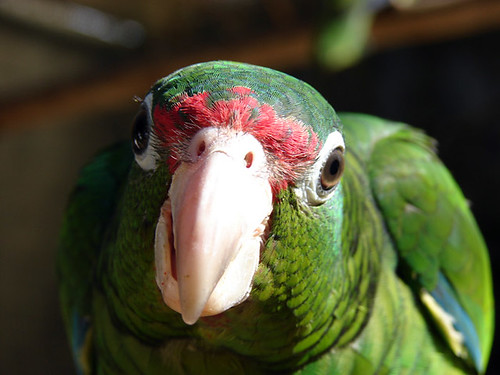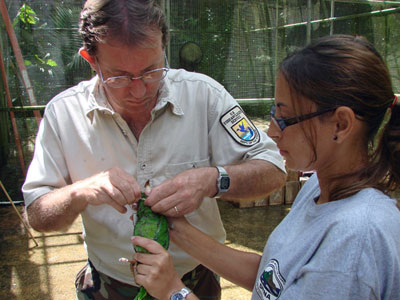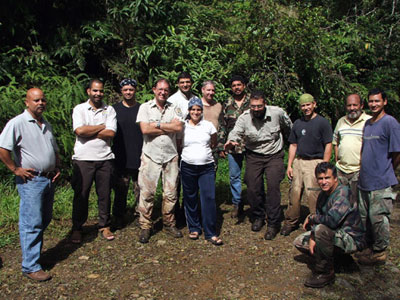 An endangered Puerto Rican parrot. Photo Credit: Pablo Torres, USFWSThe Puerto Rican parrot (Amazona vittata) is the last remaining native psittacine in United States territory, and the rarest and most endangered of the 34 species of Amazon parrots. First declared an endangered species in 1967, an intensive and ongoing recovery program for the parrot was initiated in the Luquillo Mountains, also known as the El Yunque National Forest, in 1968. Early recovery efforts focused on acquiring basic natural history data, as well as improving what was quickly discovered to be a very low nesting success rate. Then in 1973, a captive-rearing component was added to the recovery program in an effort to increase overall productivity, provide a safe haven for sick or injured wild parrot nestlings, and provide parrots for release back into wild. This aviary for raising parrots was established at an abandoned military outpost within the El Yunque National Forest.
An endangered Puerto Rican parrot. Photo Credit: Pablo Torres, USFWSThe Puerto Rican parrot (Amazona vittata) is the last remaining native psittacine in United States territory, and the rarest and most endangered of the 34 species of Amazon parrots. First declared an endangered species in 1967, an intensive and ongoing recovery program for the parrot was initiated in the Luquillo Mountains, also known as the El Yunque National Forest, in 1968. Early recovery efforts focused on acquiring basic natural history data, as well as improving what was quickly discovered to be a very low nesting success rate. Then in 1973, a captive-rearing component was added to the recovery program in an effort to increase overall productivity, provide a safe haven for sick or injured wild parrot nestlings, and provide parrots for release back into wild. This aviary for raising parrots was established at an abandoned military outpost within the El Yunque National Forest.
 Service biologist Tom White and Ana Estrella of PRDNER attach a radiotransmitter to a Puerto Rican parrot prior to its release in the Rio Abajo Forest. Photo Credit: Ivan Llerandi, PRDNERThe recovery program for the parrot has been a joint partnership between the U.S. Fish and Wildlife Service (Service), U.S. Forest Service (USFS), and the World Wildlife Fund, in conjunction with the Puerto Rico Department of Natural and Environmental Resources (PRDNER) through an official memorandum of understanding. The program has also received additional technical and logistic support from several universities, as well as numerous non-government organizations. Strategic and operational decisions are made by an interagency technical committee with members from each of the three agencies. Over the years, this three-way partnership has proven to be a highly effective means for promoting species recovery. Each partner agency provides specific advantages and benefits that further species recovery objectives that neither of the separate partners working alone could achieve.
Service biologist Tom White and Ana Estrella of PRDNER attach a radiotransmitter to a Puerto Rican parrot prior to its release in the Rio Abajo Forest. Photo Credit: Ivan Llerandi, PRDNERThe recovery program for the parrot has been a joint partnership between the U.S. Fish and Wildlife Service (Service), U.S. Forest Service (USFS), and the World Wildlife Fund, in conjunction with the Puerto Rico Department of Natural and Environmental Resources (PRDNER) through an official memorandum of understanding. The program has also received additional technical and logistic support from several universities, as well as numerous non-government organizations. Strategic and operational decisions are made by an interagency technical committee with members from each of the three agencies. Over the years, this three-way partnership has proven to be a highly effective means for promoting species recovery. Each partner agency provides specific advantages and benefits that further species recovery objectives that neither of the separate partners working alone could achieve.
As stewards of the El Yunque National Forest – the last stronghold of the wild parrots in Puerto Rico – the USFS is uniquely qualified to provide habitat protection and enhancement for the parrot, including not only the site of the original captive-rearing facility, but also the site of a new state-of-the-art breeding facility constructed within the El Yunque National Forest in 2007, and which is operated by the Service. USFS employees also work directly with Service field personnel on all aspects of parrot recovery activities, including parrot population counts, artificial nest installations, nest predator and competitor control, and improvements to trails in the parrot nesting area. The day-to-day direct management actions for the wild parrot population, including nest monitoring, radio telemetry of fledglings and releases of captive-reared birds, are performed primarily by Service field personnel.
 Members of the Puerto Rican Parrot Recovery Program during a recent semiannual parrot census in the El Yunque National Forest. Photo Credit: Ivan Llerandi, PRDNERThe PRDNER, with support from the Service, began construction of an additional parrot aviary in 1989, and several Puerto Rican Parrots were transferred there from the aviary in El Yunque in 1993. Located in the Rio Abajo Commonwealth Forest, the additional aviary is critical to ensuring against loss of the entire captive population from a single catastrophic event, such as a virulent disease outbreak or a major hurricane. Moreover, the additional and substantial production of captive-reared parrots in Rio Abajo has been instrumental in making possible not only releases of parrots to augment the relict wild population in El Yunque, but also the successful establishment of a second wild population of parrots within the Rio Abajo Forest in 2006. In fact, this new and growing population of parrots was established on the actual grounds of the Rio Abajo aviary, and the presence of the aviary captive parrots is believed to have greatly aided in encouraging released parrots to settle and establish a free-flying breeding population near the release site.
Members of the Puerto Rican Parrot Recovery Program during a recent semiannual parrot census in the El Yunque National Forest. Photo Credit: Ivan Llerandi, PRDNERThe PRDNER, with support from the Service, began construction of an additional parrot aviary in 1989, and several Puerto Rican Parrots were transferred there from the aviary in El Yunque in 1993. Located in the Rio Abajo Commonwealth Forest, the additional aviary is critical to ensuring against loss of the entire captive population from a single catastrophic event, such as a virulent disease outbreak or a major hurricane. Moreover, the additional and substantial production of captive-reared parrots in Rio Abajo has been instrumental in making possible not only releases of parrots to augment the relict wild population in El Yunque, but also the successful establishment of a second wild population of parrots within the Rio Abajo Forest in 2006. In fact, this new and growing population of parrots was established on the actual grounds of the Rio Abajo aviary, and the presence of the aviary captive parrots is believed to have greatly aided in encouraging released parrots to settle and establish a free-flying breeding population near the release site.
Looking to the future, these three longtime partner agencies have also closely collaborated to recently evaluate several potential sites for yet a third wild population of Puerto Rican parrots. A preferred candidate site has now been identified, and all necessary efforts are now underway to develop a similar reintroduction effort to that which was successfully conducted in Rio Abajo. And as before, all three agencies – the Service, USFS, and the PRDNER – will each continue to play essential and interrelated roles in this and other future recovery efforts for the Puerto Rican Parrot.